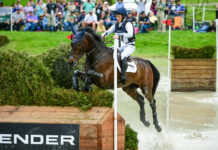Q: I ride a high-energy gelding, and every time I ride him, I cannot seem to keep a steady walk. He is always jigging and I cannot keep him down to a simple, slow walk. Any suggestions?

Since he’s a high-energy guy, work the gremlins out of his system with longeing or turnout. Outfit him in protective boots to reduce the chance of injury, and encourage him to move forward at the walk and extended trot. Let him break into a run if he feels like it, but don’t force it. When he shows signs of relaxation such as lowering his head, extending his neck, blowing air through his nose, licking and chewing, or softening his expression, it’s time to mount up.
Equipped with a snaffle or low-leverage curb bit with a soft mouth and loose shanks, ride your horse with two hands on the reins. Teach your horse to relax the muscles of his neck so that he lowers his head when he feels pressure on either side of his mouth. Begin with your horse at a standstill. Tighten one rein until you feel a firm connection between the bit and your fingertips. Maintain that pressure while you add more by tightening your ring finger against the rein for a count of “one.” Then release back to the original pressure and wait for a count of “one, two.” Repeat this until your horse responds by flexing his head to the side.
As you work on flexion, your horse will eventually start to lower his neck as he relaxes into this exercise. When he does, he’s ready to move on to the walk. Send him forward on a small- to medium-sized circle. Encourage him to bend his spine and engage his hindquarters by flexing his head slightly toward the inside of the circle, about 45 degrees. This will improve his balance and slow his gaits.
Make contact with your outside rein too. Hold it away from his neck to support the size and shape of the circle without restricting forward motion or his freedom to flex his head inward. If his walk speeds up or he elevates his head, release the outside rein, and increase the inside bend to 90 degrees until he lowers his neck and slows down.
If his perky pace persists, reestablish your outside rein. While opening it away from his neck, press your inside leg at the cinch to shift your horse’s shoulder onto a new track outside your current path. Moving his shoulders sideways will create a deeper bend in his spine and encourage him to step further under his body with his hindquarters. This change in his posture will shift his balance rearward and slow down his speedy step.
DALE RUDIN is a CHA-certified riding instructor and clinician with a mindful and balanced approach to horsemanship and riding.
www.un-naturalhorsemanship.com
This article originally appeared in the March 2015 issue of Horse Illustrated magazine. Click here to subscribe!







I laugh when I read these tips! First off, we can longe endlessly and she is very good. We can bend and stretch and she will nearly stand on her head or chase her tail with her nose, she is so flexible. The instant she is turned straight she will jig. She won’t stand at halt, she won’t walk. I have worked endless hours. She has been seen by the vet and chiropractor. She just continues the same behavior. We have moments of glory but I believe she aspires to be a parade horse, high stepping and jigging to amaze the crowd! 🙂
Have you ever tried to do a ton of change of directions? Rollbacks on the fence at a canter? How about backing in a circle or figure eights? Backing around trees, side passing at trot or canter? Don’t always go forward. Also back him up every where you walk him, back into stall,back into paddock. That will humble a horses attitude by backing. Move his feet somewhere other than straight forward or big circles, do the opposite of where he wants to go. Then when he is listening to you try a walk. Let him get his air back at a walk, see what happens.
Have you ever tried to do a ton of change of directions? Rollbacks on the fence at a canter? How about backing in a circle or figure eights? Backing around trees, side passing at trot or canter? Don’t always go forward. Also back him up every where you walk him, back into stall,back into paddock. That will humble a horses attitude by backing. Move his feet somewhere other than straight forward or big circles, do the opposite of where he wants to go. Then when he is listening to you try a walk. Let him get his air back at a walk, see what happens.